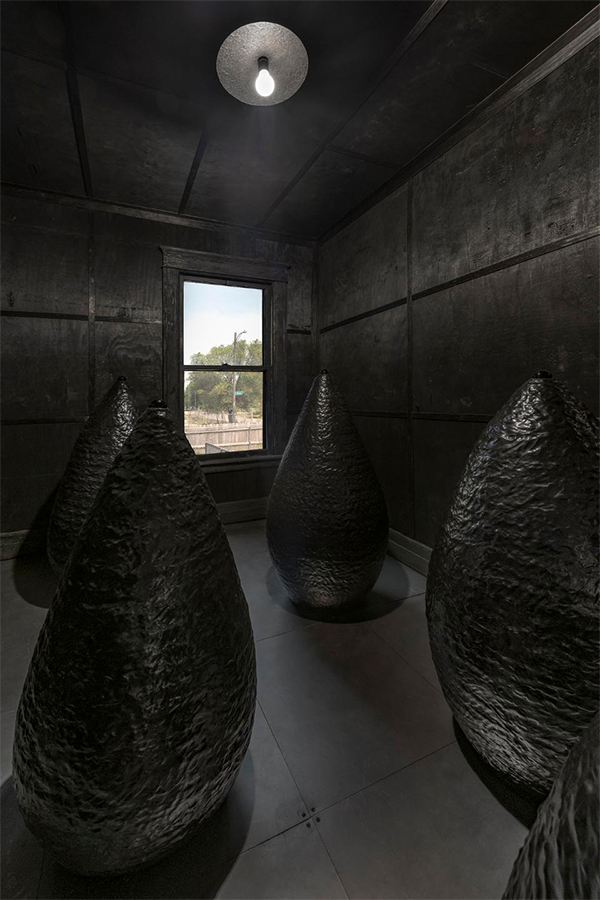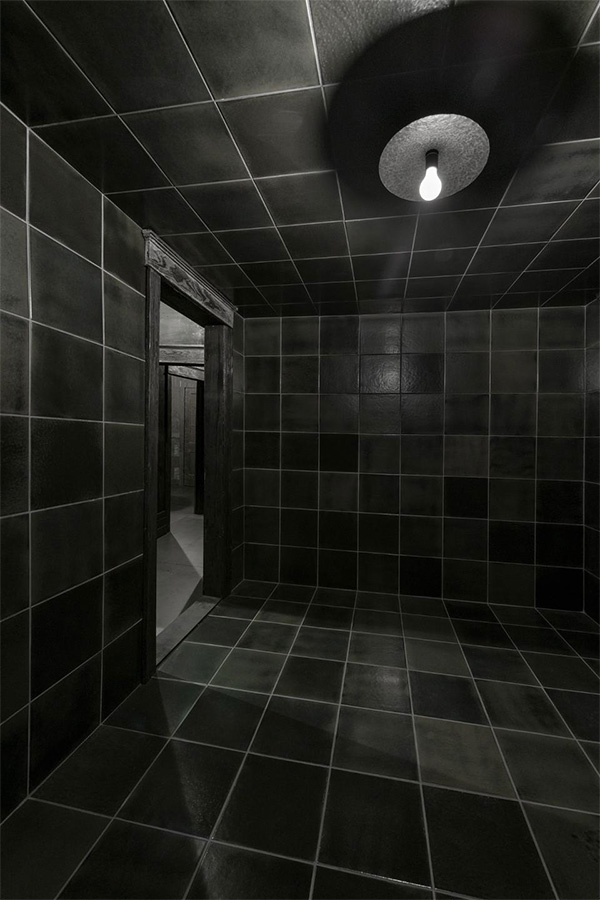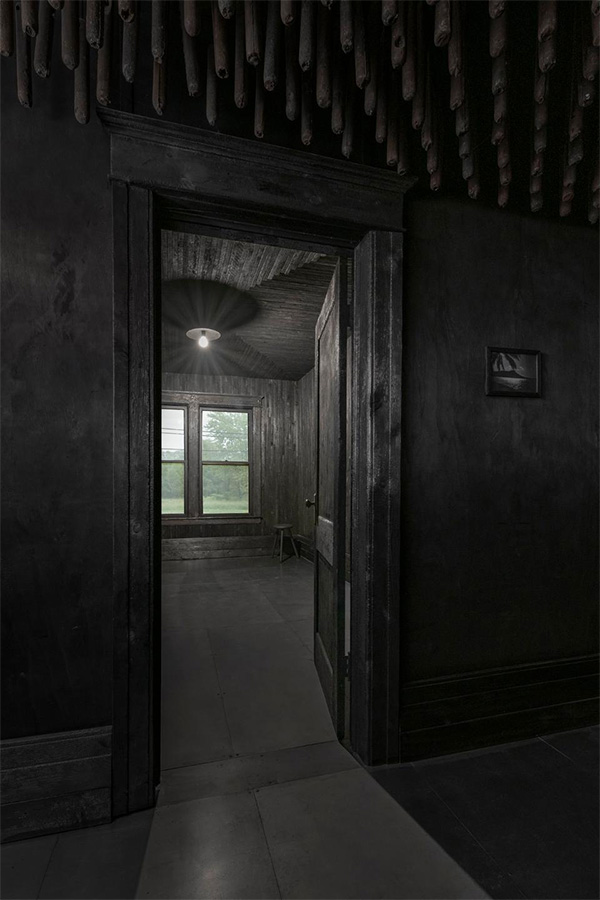
- Source: FORBES
- Author: NATASHA GURAL
- Date: JULY 21, 2019
- Format: DIGITAL
Wander Into A Dim, Daring Art Installation That Evokes Detroit’s Troubled Past And Rattles Your Own Memories

View of one of seven rooms in "Unit 1: 3583 Dubois", Anders Ruhwald’s permanent art installation. ANDERS RUHWALD
“Where should I go?” asked Alice. “That depends on where you want to end up,” replied the Cheshire Cat.
I carefully navigated the caliginous space, walking attentively into a room with tiled floor, walls, and ceiling, a radiator, and light fixture. At first I wasn’t sure if I was losing my balance, or if the ground below me was slanted. Standing firmly to steady myself, I determined it was the floor askew and not a sudden bout of vertigo.
“You get off balance and get this unsettling notion,” explained artist Anders Ruhwald. “You’re not sure if you’re off or room is off. “

Tiled room in "Unit 1: 3583 Dubois" ANDERS RUHWALD
The entire installation is intended to rattle your sensibilities and draw from your own past. “I’m very interested in notions of abstraction,” he said. “I don’t have a particular program of how I want people to experience the place.”
“I’m interested in it being a de-stabilization of the plane you are walking on,” said Ruhwald. “I’m interested in the installation existing at dusk, when it’s neither light nor dark. You start losing sense of what is real or imaginary. It begins to open in your mind the surreal notion that you step on the floor and suddenly we took out the floor.”
I grew curiouser and curiouser as I wandered around each wildly individual room in the 1,700 square foot apartment that’s been re-imagined by Ruhwald using charred wood, metal, glass, and ceramics. It was my second visit to Unit 1: 3583 Dubois, Ruhwald’s permanent art installation, a highlight of Detroit Art Week, produced by Olu & Company.
“When I came to Detroit, most of the city was unlit outside the thoroughfare. Most of the light posts had been taken down by scrappers. Going through city at night was amazing because there were no lights, houses were abandoned, and I was thinking about how a large urban landscape that’s unlit functions,” said Ruhwald. “There has been a lot of blight tourism in Detroit. For me, the installation is about interiorizing that experience. For me, it’s about making that experience more intimate and more real.”
At first it seems like the rooms had been set ablaze, maybe with a blowtorch. More careful inspection reveals how Ruhwald painstakingly crafted each room to evoke a sense that the home has been damaged in a fire. I was immediately reminded of an escape room in New York based on the 1865 novel Alice’s Adventures in Wonderland, but sinister, thereby even more suited to my aesthetic.
“The president of the (John S. and James L.) Knight Foundation, one of the main funders for the place, came through when it was almost done and it turns out that his childhood home had burned down,” said Ruhwald. “For him it became a very profound experience.”

Building exterior ANDERS RUHWALD
Ruhwald bought the building in 2014 with the intention of using it for the installation, but he lived in another part of the house for about a year with his wife and two children before the project, a five-year process, took form.
“For me the idea behind the installation is pretty much in the fabric of the city. It’s something more incorporated in the neighborhood setting,” he said. “I’m very interested in the erasure of the buildings in Detroit since I have been living here.”
Throughout the seven rooms, surfaces have been altered using burning, charring, glazing, and painting. Some everyday household objects are preserved, but the only reminder of the previous owner is a small image of a beach in Hawaii hung on the wall to your left as you enter the first room from the bright blue and white stairway.

View of one of seven rooms in "Unit 1: 3583 Dubois", Anders Ruhwald‘s permanent art installation ANDERS RUHWALD
The photo is dated Feb. 6, 1941, and “probably taken by a service man stationed there a half year before Pearl Harbor,” Ruhwald speculated. Displaying that image “is a way of introducing the complications of the auto industry in the city. All of the auto industry was turned into war industry, setting it up to become the manufacturing city it was.”
Ruhwald uses that single personal possession to “carry that story in a very ephemeral way.”
“It’s the only found object from the former owner I kept,” said Ruhwald. “When I bought the building, it was filled with items, and I cataloged stuff that was personal. The owner had died and his family didn’t want any of the stuff.”

Bathroom covered in pet coke ANDERS RUHWALD
The bathroom, enveloped in a distinctly different surface, elevates Ruhwald’s story of the controversial city, using pet coke (or petroleum coke), a final carbon-rich solid material that derives from oil refining. In April, the mayoral administration rejected Marathon Petroleum Corp.’s request to continue storing pet coke in an uncovered pit after years of gripes from southwest Detroit residents about clouds of black dust blowing in the air and into the Detroit River. Marathon had stored pet coke in a 30-foot deep pit in Detroit since 2012 for use in utility boilers and kilns.
“Massive black clouds swelled around the city,” Ruhwald said. Including the soot-like black substance in the bathroom “deals with auto industry, and also one of the reasons that Detroit is such an underappreciated place,” he said. “Companies can take advantage of storing such substances in poor neighborhoods.”
Tempted by all things tenebrous, I was eager to return yesterday and re-experience Ruhwald’s immersive, otherworldly seven-room space which I’d first explored last month while visiting Cranbrook Art Museum and Educational Community in Bloomfield Hills, about a half hour drive from Detroit. Like many of the city’s working artists, Ruhwald has a strong Cranbrook connection; he taught ceramics there from 2008 to 2017.
Art and culture are essential to fueling Detroit’s current upswing after decades of turmoil that’s left much of the city blighted.
“I moved to Detroit in 2008 when financial crash happened,” recalled Ruhwald. “There was kind of a kernel of optimism just before the crash. I moved from Chicago. I had been sort of a migrant artist in the U.S. since graduating from the Royal College of Art (in London) in 2005.”
Born in Randers, Denmark, in 1974, Ruhwald graduated from the Royal Danish Academy of Fine Arts, School of Design, in 2000.
Over five days, DAW welcomes locals and tourists to participate in a wide array of exhibitions, studio visits, performances, panel discussions, and programming, while also delving into the city’s lively nightlife.

